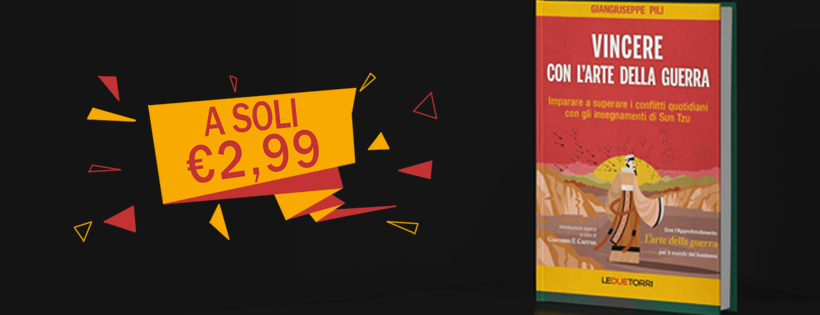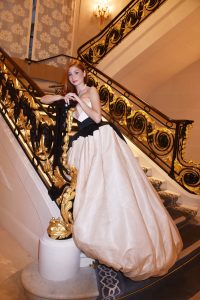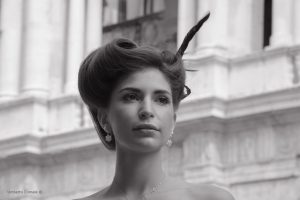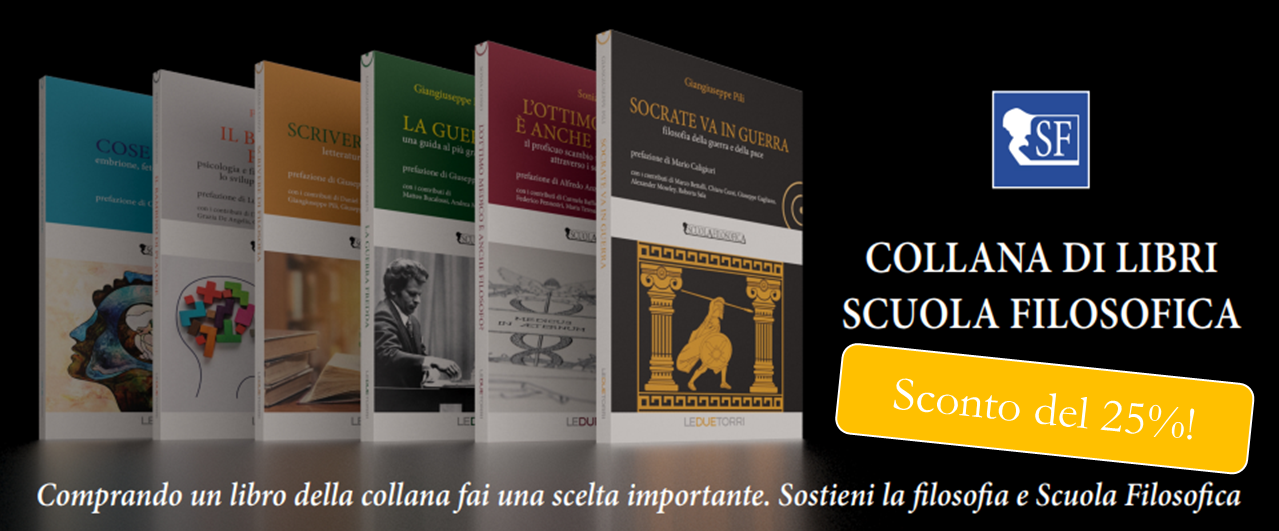Per Rosamund Marriott Watson, liricamente l’oro della cascata in natura è la scalinata d’un legato per l’uomo. Più realisticamente, sognando i pensieri scorrono ipnotici, per un labirinto dell’orientamento. Da questo, “ci si risveglia” con la maestria nel canto. Altea ha posato all’inizio d’una scalinata. L’ambiente si percepisce lussureggiante, mediante le decorazioni a foglia d’oro sulla ringhiera. Altea porta un abito bianco da ballo, con lo strascico. Sulla ringhiera ci piace immaginare un pentagramma per una “fiamma” dell’infinito (dal suo simbolo). La trasfigurazione si percepisce all’impossibilità che la corporeità “coli” sull’orizzonte dell’immanenza. La colonna all’inizio della scalinata avrebbe una foglia d’oro addirittura alla risonanza d’un flauto. Proprio lì s’indirizzerebbero le dita delle mani. Altea ha un caschetto di capelli rossi, dando alla foglia d’oro una passionalità “nobilitata” dall’intelletto, tramandando un’eleganza di stile contro uno scivolamento al suolo marrone del materialismo (dal tappeto).
According to Rosamund Marriott Watson, lyrically the gold of a fall in nature is the staircase of a legato for the man. More realistically, when we dream the thoughts flow hypnotic, for the maze of an orientation. From this one, “we reawaken” with the mastery in singing. Altea posed at the beginning of a staircase. The setting is perceived luxuriant, through the decorations of gold leaf on the railing. Altea wears a white ball gown, with the train. On the railing we like imagining a staff for a “flame” of the infinity (from its symbol). The transfiguration is perceived in the impossibility of a corporeality that “pours slowly” on the horizon of the immanence. The column at the beginning of the staircase would have a gold leaf even at the resonance from a flute. Exactly there the fingers of the hands would be directed. Altea has a red bob haircut, allowing the gold leaf to have a passionateness “ennobled” by the intellect, bequeathing an elegance of style against a slipping into the brown soil of the materialism (from a carpet).
(courtesy to Jean-Luce Huré)
Francis Scott Fitzgerald immagina l’augurio d’essere una piuma anziché un piombo, così da galleggiare senza il trascinamento (o peggio l’affondamento). Per ammaliare “onestamente”, l’uomo può ricorrere all’arte della danza. Jessica ha posato in uno scatto al bianconero. Il mezzobusto si riduce alle spalle, cercando in compenso una sorta di “basamento” per un terrazzo della Basilica Palladiana, a Vicenza. La pettinatura di Jessica è old style, per un evento di moda sul medesimo tema. Lei ha un volto che si percepisce quasi lungimirante. Al di là sia del fashion sia del glamour, aumenterà l’intellettualismo. Ogni epoca ha la sua cultura. C’entra lo sguardo verso la nostra destra, mentre la testa “rimbalzerebbe” dall’attrito con i vetri delle finestre, o comunque dalla pressione degli archi. La Basilica Palladiana artisticamente è conosciuta a livello mondiale. Dalla pettinatura si stacca una penna nera d’uccello, la quale dovrà galleggiare su un “mulinello”, ma senza per questo svuotarsi come una fessura fra le colonne (all’angolo in alto a destra).
Francis Scott Fitzgerald imagines that he is a feather instead of a plummet, so to float without dragging (or worse the sinking). To bewitch “honestly”, the man can resort to the art of dance. Jessica posed in a shot with the black and white. The half-bust is reduced to the shoulders, looking for on the other hand a sort of “base” for a terrace of the Basilica Palladiana, in Vicenza. The hairdo of Jessica is old-style, for a fashion event about the same theme. She has a face that we perceive almost forward-thinking. Beyond both the fashion and the glamour, the intellectualism will increase. Every age has the own culture. The gaze to our right is important, while the head “would bounce” from the friction with the window panes, or however from the pressure of the arches. The Basilica Palladiana artistically is known worldwide. From the hair, the black feather of a bird detaches, and this one will have to float on a “whirlpool”, but without emptying out as a crack between the columns (in the top right corner).
(courtesy to Umberto Cornale)
Per Sinisgalli, liricamente la temporalità è continua se un bimbo suona la cornetta mentre un soldato passa a cavallo, e se s’apre una crepa improvvisa sul soffitto mentre la melagrana a terra si spacca. Principalmente la musicalità appartiene ad un tipo di sensazione che sa coinvolgerci meglio. Per Sinisgalli, nell’insieme varrà l’evento d’un attimo rivelatore. Le sorelle Gaia e Luna Carollo compongono un duo musicale. Loro sono state inquadrate alla postazione del disc jockey, in un locale. La fotografia ci rimanda grossomodo ad un piano americano. Sullo sfondo l’insegna chiarisce che le due artiste sono state inquadrate ad un loro evento. Gaia quasi mimerebbe una cornetta, con le dita della mano destra. Sarà un modo per contattare la… falce di Luna (citando ovviamente la sorella). Ambedue le ragazze sorridono assai divertite. In Gaia la “cornetta” sarebbe pure quella… strumentistica, guardandola in completamento con le cuffie sulla nuca. Le dita dovranno fungere da “pistoni”. Gaia veste il rosso, mentre Luna il nero. Le luci d’una discoteca si percepiscono “fruttuose” poiché psichedeliche, rispetto alla notte. Luna è stata inquadrata lievemente “all’inchino”, e soprattutto a causa delle braccia tese: dunque sembra la posa d’una cavalcata (se non altro fra i dischi, per il classico medley). In alto, lo squarcio d’un faro colpirebbe la testa di Gaia: chissà quanto ad ispirarla.
According to Sinisgalli, lyrically the temporality is continuous if a child plays the cornet while a soldier goes on horseback, and if a sudden crack opens on the ceiling while the pomegranate splits on the ground. Principally the musicality belongs to a type of sensation that is able to involve us in better way. According to Sinisgalli, overall the event of a revealing moment will be valid. The sisters Gaia and Luna (translated in English as ˂ Moon ˃) Carollo compose a musical duo. They were framed to the workstation for a disc jockey, in a club. The photography refers us approximately to a cow-boy shot. On the background the sign explains that the two artists were framed during one of their events. Gaia almost would mime a handset, with the fingers of the right hand. That will be a way to contact the… crescent moon (mentioning of course the sister). Both girls smile very amused. In Gaia the “handset” would be also the same of… a musical instrument, watching it in completion of the headphones on the nape. The fingers will have to function as “pistons”. Gaia wears the red, while Luna wears the black. The lights of a discotheque are perceived “fruitful”, because they are psychedelic, compared to the night. Luna was framed slightly doing “a curtsy”, and principally because of the arms outstretched: so it seems the pose of a horse riding (if nothing else between the discs, for the typical medley). Above, the gash of a floodlight would hit the Gaia’s head: who knows how much for her inspiration.
(courtesy to Agostino Carollo)
Bibliografia – Bibliography
BALDELLI S., Antologia della poesia femminile europea da Saffo al Novecento, Youcanprint, Tricase 2020
FITZGERALD F.S., Tenera è la notte, Feltrinelli, Milano 2015
SINISGALLI L., Tutte le poesie, Mondadori, Milano 2020
Biografia – Biography
La modella italiana Altea Patrizi Naro Montoro nasce a Roma. Lei ha studiato alla Nuova Accademia di Belle Arti.
The Italian model Altea Patrizi Naro Montoro was born in Rome. She studied at the New Academy of Fine Arts.
Il fotografo francese Jean-Luce Huré nasce nel 1942 a Parigi. Egli scatta a livello internazionale. La giornalista Suzy Menkes ha scritto una volta, per il The New York Times: ˂ Jean-Luce Huré è quello che i giapponesi chiamano “un maestro nel suo lavoro”, poiché, come la cassa d’un tesoro, contiene la chiave per la storia della moda ˃.
The French photographer Jean-Luce Huré was born in 1942 in Paris. He shoots at international level. The journalist Suzy Menkes wrote one time, for The New York Times: ˂ Jean-Luce Huré is an example of a so-called “master at his work”, for the Japanese people, because, as a treasure chest, he contains the key for the history of fashion ˃.
https://www.instagram.com/jeanlucephoto/
La modella italiana Jessica Zuanetto viene da Limena (PD).
The Italian model Jessica Zuanetto comes from Limena (Province of Padua).
Il fotografo italiano Umberto Cornale nasce nel 1956 a Valdagno (VI). I suoi scatti sono stati esposti molte volte. Umberto si fa ispirare dalla cultura mitteleuropea, ed alla prassi preferisce evitare il condizionamento moderno del digitale.
The Italian photographer Umberto Cornale was born in 1956 in Valdagno (Province of Vicenza). His shots have been exhibited many times. Umberto gets inspired by the Middle-European culture, and at the praxis he prefers to avoid the modern conditioning of the digitalization.
www.umbertocornale.it
Le modelle italiane Gaia (nata nel 1998) e Luna (nata nel 2001) Carollo sono sorelle. Loro crescono a Rovereto (TN), ispirate dal padre musicista. Nel 2007, Gaia e Luna ottennero il primo successo, grazie alla canzone Come Vasco Rossi.
The Italian models Gaia (born in 1998) and Luna (born in 2001) Carollo are sisters. They grew up in Rovereto (Province of Trento), inspired by the father musician. In 2007, Gaia and Luna obtained the first success, through the song Come Vasco Rossi.
https://music.apple.com/it/artist/gaia-luna/253267651
Il fotografo italiano Agostino Carollo nasce a Rovereto (TN) nel 1966. Padre di Gaia e Luna, egli è un famoso musicista, di livello mondiale, in specie per il genere house. Agostino oggi dirige la casa discografica Everness.
The Italian photographer Agostino Carollo was born in Rovereto (Province of Trento) in 1966. Father of Gaia and Luna, he is a famous musician, worldwide, especially for the house genre. Today Agostino manages the record company Everness.
www.everness.com







Be First to Comment